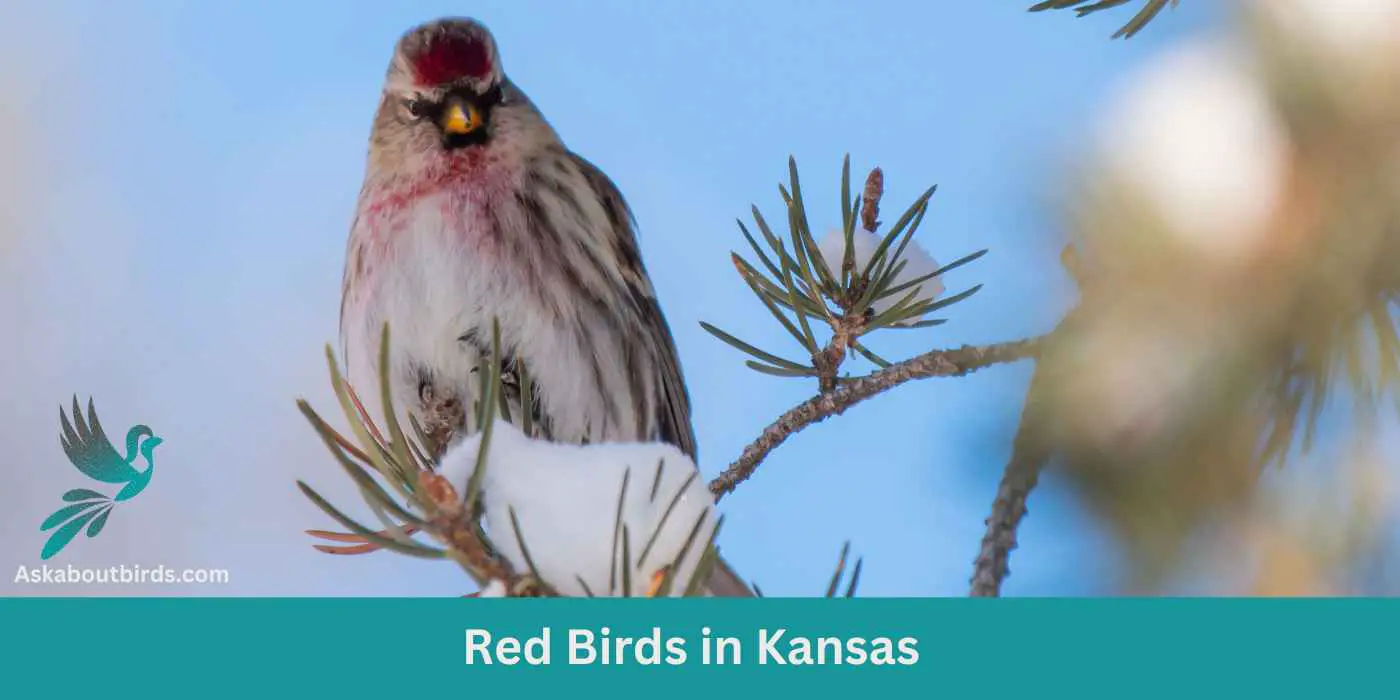Kansas boasts vast rolling prairies, fertile farmlands, and meandering rivers that define its landscape. The state, often recognized for its sweeping plains and rich agricultural history, is also a haven for bird enthusiasts.
Its diverse habitats play host to a myriad of avian species, particularly those adorned in radiant shades of red.
Dive into our curated list of 13 remarkable red birds that grace the Sunflower State, and enhance your birdwatching experience with our complimentary photo guide.
Red Birds Found In Kansas
Beyond the golden waves of wheat and sunflower fields, Kansas offers a mosaic of habitats. From its wetlands in the east to grasslands in the west, the state’s diverse ecosystems attract a plethora of bird species.
The availability of food, shelter, and nesting sites, coupled with minimal urban interference in many areas, makes Kansas an avian haven, nurturing a rich and varied bird population.
Northern Cardinal


| Feature | Measurement |
|---|---|
| Scientific Name | Cardinalis cardinalis |
| Length | 8.3 – 9.1 in |
| Wingspan | 9.8 – 12.2 in |
| Weight | 1.19 – 2.29 oz |
The Northern Cardinal is an iconic North American bird, easily recognized by its vibrant color and melodious song.
Appearance: Male Northern Cardinals are a brilliant scarlet red, while females display a more subdued reddish olive. Both sexes have a distinctive black ‘mask’ on their face around the bill and a pointed crest on their head. The bird’s beak is robust, cone-shaped, and bright orange in color.
Diet: Northern Cardinals are primarily granivorous, with a diet largely consisting of seeds and grains. They also eat fruits and insects. These birds typically feed off the ground and are frequent visitors to bird feeders.
Reproduction: Northern Cardinals are monogamous, and a pair will breed together for life. The female typically builds a well-hidden nest in a dense thicket or shrub. She lays 2-5 eggs per clutch, which she incubates for around two weeks.
Summer Tanager


| Feature | Measurement |
|---|---|
| Scientific Name | Piranga rubra |
| Length | 6.7 in |
| Wingspan | 28 to 30 cm |
| Weight | 29 g |
The Summer Tanager is a medium-sized songbird admired for its radiant plumage and melodious song.
Appearance: Male Summer Tanagers are an impressive bright red, while females and juveniles present a softer, yellow-orange color. Both genders have a large, slightly hooked bill and relatively short tail.
Diet: Summer Tanagers primarily feed on insects, including bees and wasps, which they catch in flight or pick off vegetation. They are also known to eat fruits and berries, making them helpful in controlling pest populations and seed dispersal.
Reproduction: The female Summer Tanager builds a loose, shallow cup-shaped nest out of twigs and grass, usually hidden in the foliage of trees. The female typically lays 3-5 eggs, which she will incubate for about two weeks.
Scarlet Tanager


| Feature | Measurement |
|---|---|
| Scientific Name | Piranga olivacea |
| Length | 6.3 to 7.5 in |
| Wingspan | 9.8 to 11.8 in |
| Weight | 23.5 to 38 g |
The Scarlet Tanager is a strikingly colorful bird known for its brilliant plumage and distinctive song.
Appearance: Male Scarlet Tanagers are notable for their vibrant scarlet bodies contrasted with black wings and tail, making them one of the most intensely colored birds. Females and juveniles, on the other hand, have a subdued olive-yellow body color with darker wings and tail.
Diet: The diet of the Scarlet Tanager is largely made up of insects, including beetles, cicadas, aphids, and others. They are adept flycatchers, seizing insects in mid-air or picking them off foliage. They also consume fruits and berries, especially during migration and in their winter habitats.
Reproduction: The female Scarlet Tanager builds a cup-shaped nest using twigs, rootlets, and grass, typically well-hidden in the dense foliage of trees. She lays 3 to 5 eggs and incubates them for about two weeks.
Vermilion Flycatcher
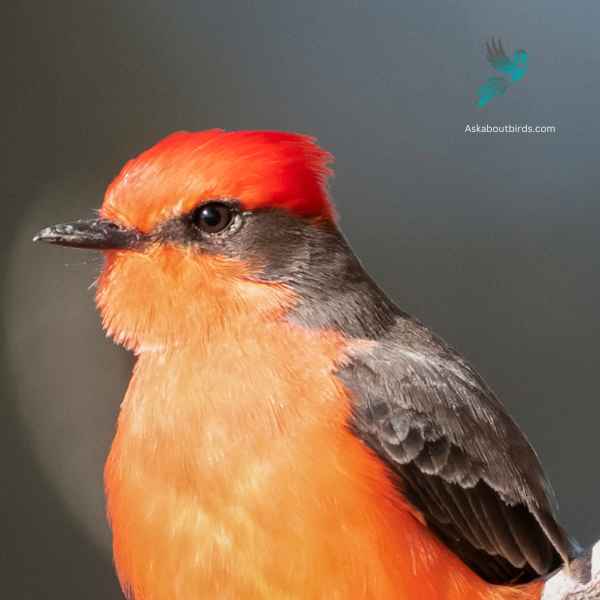

| Feature | Measurement |
|---|---|
| Scientific Name | Pyrocephalus obscurus |
| Length | 5.1–5.5 in |
| Wingspan | 9.4 to 9.8 in |
| Weight | 11 to 14 g |
The Vermilion Flycatcher is a small and colorful bird native to the Americas. The male Vermilion Flycatcher is a striking sight, displaying a vibrant red plumage on its head, breast, and underparts, contrasting with its brown wings and black tail below. Females, on the other hand, have more muted colors, featuring a pale yellowish belly and grayish-brown upperparts.
Vermilion Flycatchers are known for their lively and acrobatic flight displays, which they perform during courtship or to defend their territories. They often sing a series of soft, whistled notes while engaged in these aerial displays. They construct cup-shaped nests, usually in shrubs or low trees, where females lay their eggs and raise their young.
Red-headed Woodpecker

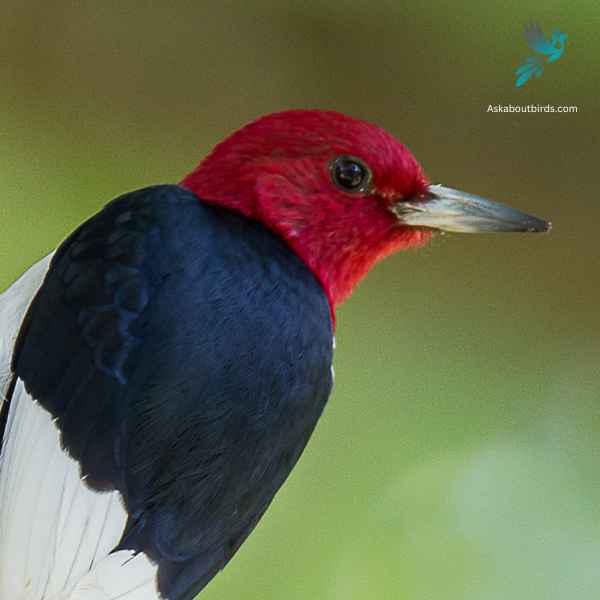
| Feature | Measurement |
|---|---|
| Scientific Name | Melanerpes erythrocephalus |
| Length | 7.5–9.1 in |
| Wingspan | 16.5 in |
| Weight | 2.0–3.2 oz |
The Red-headed Woodpecker is a striking forest bird with a bold tri-colored pattern.
Appearance: This woodpecker features a completely red head and neck, contrasting starkly with its white underparts and black wings. Its wings also have large white patches which are conspicuous in flight.
Diet: Red-headed Woodpeckers have a varied diet including insects, seeds, fruits, berries, and occasionally even the eggs of other birds. They’re also known to store food by wedging it into crevices in bark.
Reproduction: These woodpeckers nest in cavities which they excavate in dead wood or dead parts of live trees. These cavities can be found anywhere from 2 to 80 feet off the ground.
Red Crossbill
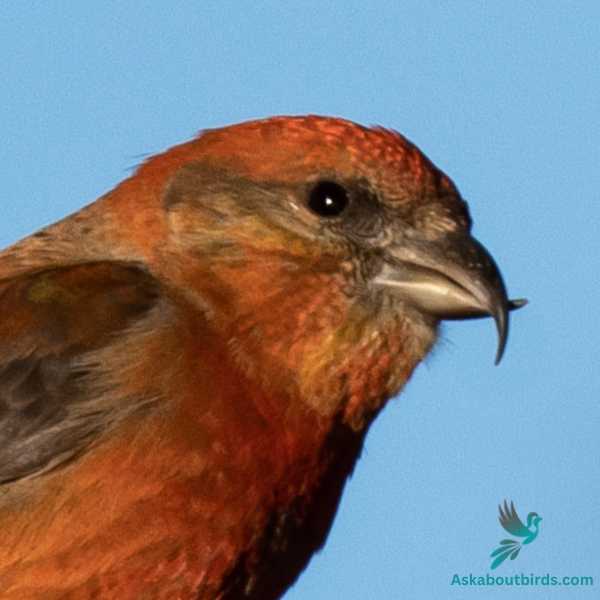

| Feature | Measurement |
|---|---|
| Scientific Name | Loxia curvirostra |
| Length | 20 cm |
| Wingspan | 27–29 cm |
| Weight | 40-53 g |
The Red Crossbill is a peculiar bird species, celebrated for its unique beak structure and vibrant coloration.
Appearance: Red Crossbills are named for their distinctive crossed mandibles, which are adapted to extracting seeds from conifer cones. Male Red Crossbills are usually bright red or orange, while females and juveniles are greenish-yellow. All have dark wings and notched tails.
Diet: The diet of the Red Crossbill is primarily composed of conifer seeds, their unique beak allowing them to access these seeds with ease. This diet includes seeds from pine, spruce, and other types of coniferous trees. They are also known to consume some insects.
Reproduction: Red Crossbills are known for their flexible breeding season, which can occur any time of the year when there is an abundance of food. They typically nest in conifers, where the female lays a clutch of 3 to 4 eggs.
House Finch


| Feature | Measurement |
|---|---|
| Scientific Name | Haemorhous mexicanus |
| Length | 5–6 in |
| Wingspan | 8–10 in |
| Weight | 0.6–0.9 oz |
The House Finch is a small songbird widely distributed across North America and is commonly found in urban and suburban areas.
Appearance: Males of this species are brightly colored with crimson faces and throats, which can extend to the chest and back, while their flanks have streaks. The female is streaked brown and lacks the red coloring. Both have a square-tipped tail and a distinctively long, flat-topped bill.
Diet: House Finches primarily eat seeds, grains, and berries. They have a particular fondness for sunflower seeds and can be commonly seen at bird feeders. Occasionally, they will also consume insects, especially during the breeding season.
Reproduction: House Finches are cavity-nesters and might choose ledges, vents, ledges, and other urban settings. They might also utilize trees or shrubs. Their nests can be made of a wide array of materials, from feathers to twigs.
Purple Finch


| Feature | Measurement |
|---|---|
| Scientific Name | Haemorhous purpureus |
| Length | 4.7–6.3 in |
| Wingspan | 4.7–6.3 in |
| Weight | 0.6–1.1 oz |
The Purple Finch is a vibrant songbird often mistaken for its close relative, the House Finch, but it exhibits a different hue and patterns.
Appearance: Males are raspberry red on the head, throat, and breast, with streaky brown backs and wings. The intensity of the red can vary among individuals. Females are brown and streaked all over but might show a slight blush on the face. They lack the strong facial patterns seen in female House Finches.
Diet: Purple Finches primarily consume seeds, with a preference for sunflower seeds, dandelion seeds, and buds. They also eat insects and berries, especially during the breeding season.
Reproduction: These finches often nest in conifers or mixed woodlands. The nest, typically located on a horizontal branch, is made from twigs and grass, then lined with feathers.
Pine Grosbeak

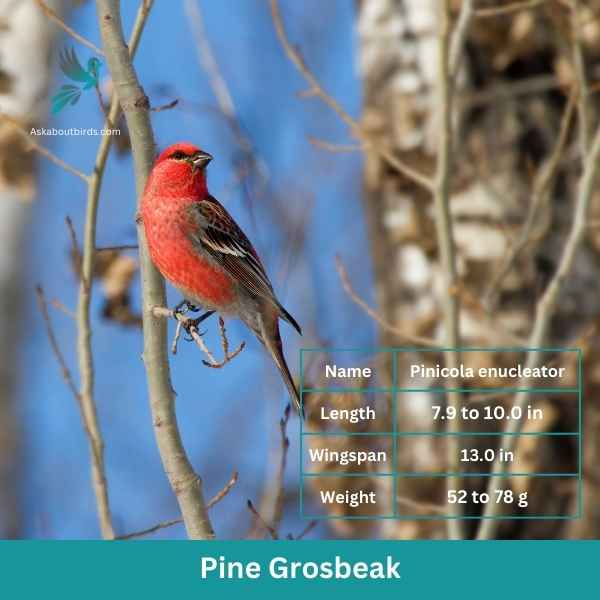
| Feature | Measurement |
|---|---|
| Scientific Name | Pinicola enucleator |
| Length | 7.9 to 10.0 in |
| Wingspan | 13.0 in |
| Weight | 52 to 78 g |
The Pine Grosbeak is a striking bird native to the northern regions of North America, often found in coniferous forests. Both males and females have a plump and robust body with a large beak adapted for eating seeds. The male Pine Grosbeak displays a vibrant reddish-pink plumage, while the female has a more subdued grayish-brown coloration.
These birds are typically seen in small flocks, foraging for food in trees and on the ground. They have a preference for seeds, particularly those from various conifer species. The Pine Grosbeak uses its strong bill to crack open the cones of tall trees and extract the seeds, but they also consume berries and small fruits when available.
Rose-breasted Grosbeak
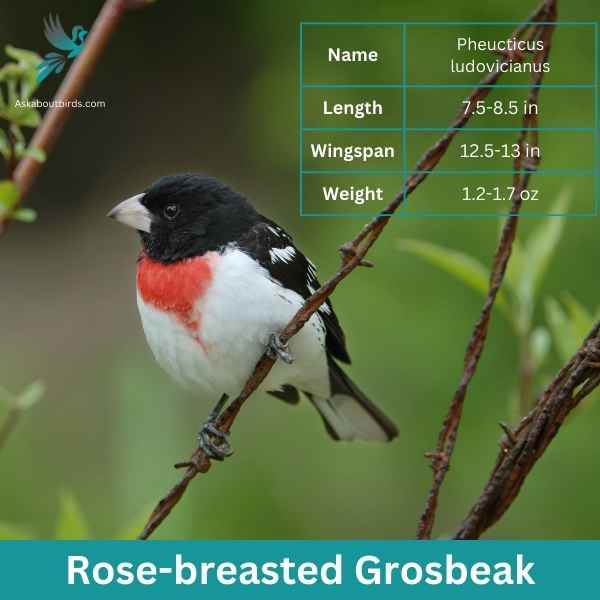

| Feature | Measurement |
|---|---|
| Scientific Name | Pheucticus ludovicianus |
| Length | 7.5-8.5 in |
| Wingspan | 12.5-13 in |
| Weight | 1.2-1.7 oz |
The Rose-breasted Grosbeak is a songbird of medium size, widely recognized for its vibrant coloration and melodious song.
Appearance: Male Rose-breasted Grosbeaks boast a striking contrast with black and white plumage accompanied by a radiant rose-colored patch on the chest and under the wings. In contrast, females exhibit streaked brown and white plumage, resembling large sparrows but with a thick bill.
Diet: The diet of the Rose-breasted Grosbeak consists of a mixture of seeds, insects, and fruits. During summer, they primarily feed on insects, while seeds and fruits become more prevalent in their diet during the colder months.
Reproduction: These birds build cup-shaped nests typically situated in trees or large shrubs. Both the male and female partake in incubation duties, ensuring the eggs’ safety and warmth. After hatching, the chicks are primarily fed insects.
Common Redpoll

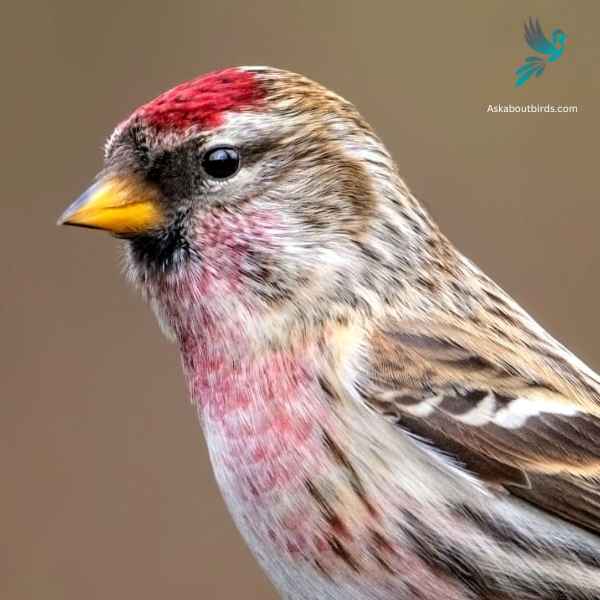
| Feature | Measurement |
|---|---|
| Scientific Name | Acanthis flammea |
| Length | 5.0-5.5 in |
| Wingspan | 7.5-8.5 in |
| Weight | 0.4-0.9 oz |
The Common Redpoll is a small songbird that is easily identifiable by its rosy-red forehead, black chin, and often fluttering flight pattern.
Appearance: Common Redpolls exhibit a distinctive rosy-red forehead patch and black chin. The males typically have a more extensive pink wash on their chest and face than females. The rest of their body is primarily streaked brown and white, with two white wing bars and a notched tail.
Diet: The diet of the Common Redpoll predominantly consists of seeds, particularly from birches and alders. They have a specialized throat pouch where they can temporarily store seeds, allowing them to consume them later in a more sheltered location.
Reproduction: Common Redpolls nest in shrubs or on the ground, using grasses, twigs, and feathers for construction. The female is responsible for the majority of the incubation and typically lays a clutch of 4 to 6 eggs. After the eggs hatch, both parents take part in feeding the young.
American Robins


| Feature | Measurement |
|---|---|
| Scientific Name | Leptotila plumbeicep |
| Length | 10.6-11.8 in |
| Wingspan | — |
| Weight | 160-200 g |
The American Robin is a widely recognized bird species known for its melodious song and early bird tendencies.
Appearance: American Robins are medium-sized birds with a distinctive appearance. Both males and females sport a gray to brown back and a warm red to orange breast and belly and gray wings. They also have a characteristic white eye-ring and a black head, but males are usually darker than females.
Diet: American Robins have a diverse diet that changes depending on the season. In summer, they feed heavily on earthworms, beetles, and other invertebrates, which they catch on the ground. During winter, they mostly eat fruits and berries.
Reproduction: American Robins usually build their nests in trees or shrubs, but they are also known to nest on human-made structures. The female lays a clutch of about 3 to 5 eggs, which she incubates for about 12 to 14 days.
Rufous-sided (Eastern) Towhee
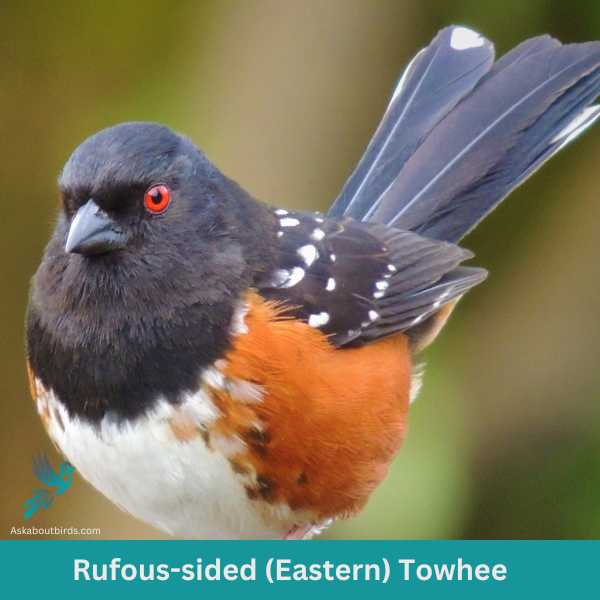
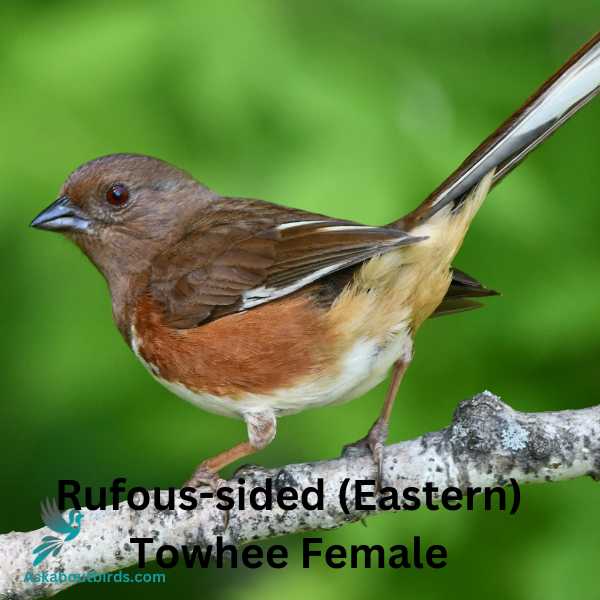
| Scientific Name | Pipilo erythrophthalmus |
| Length | 6.75 to 8.25 inches |
| Wingspan | 7.9 to 11 inches |
| Weight | 1.1 to 1.8 ounces |
The Rufous-sided Towhee, more commonly known as the Eastern Towhee, is a striking bird distinguished by its vivid coloration and melodious calls.
Appearance: Male Eastern Towhees are characterized by their black upper bodies, rufous flanks, and white underbellies. Females share the same pattern but are brown where the males are black. Both sexes have a distinctive red eye.
Diet: Eastern Towhees primarily feed on the ground, rummaging through leaf litter for seeds, berries, and insects. Their diet can vary seasonally, with more insects in warmer months and seeds during winter.
Reproduction: Eastern Towhees nest on or near the ground, typically in shrubs or dense vegetation. The female constructs the nest and incubates a clutch of 2 to 5 eggs, which hatch after about 12 days.
Where to Spot Kansas’ Red Birds
Kansas, with its diverse habitats and central location, is a treasure trove for bird enthusiasts. Here are some prime locations to witness the spectacular array of avian wonders, especially the vibrant red birds:”
- Cheyenne Bottoms Wildlife Area: One of the largest inland marshes in the U.S., this area attracts hundreds of bird species during migration seasons. A hotspot for both waterfowl and songbirds.
- Quivira National Wildlife Refuge: Encompassing over 22,000 acres of salt marshes, this refuge is a critical stopover for migratory birds. The diverse habitat also supports numerous resident birds year-round.
- Tallgrass Prairie National Preserve: This preserve represents one of the last remaining expanses of tallgrass prairie in the U.S. Home to an impressive array of grassland birds, it offers a unique birding experience.
- Wilson Lake: Situated in the Smoky Hills, this lake is surrounded by native prairie and rocky outcrops, making it a favorite spot for diverse bird species, from waterfowl to raptors.
- Marais des Cygnes Wildlife Area: Nestled in eastern Kansas, its bottomland hardwood forests and marshes beckon a rich diversity of bird species, making it a must-visit for avid bird watchers.
| State’s Red Birds | Best Spots to See Red Birds |
|---|---|
| Nebraska’s Red birds | 1. Fontenelle Forest 2. Indian Cave State Park 3. Platte River State Park |
| Missouri’s Red birds | 1. Mingo National Wildlife Refuge 2. Mark Twain National Forest 3. Busch Conservation Area |
| Oklahoma’s Red birds | 1. Wichita Mountains Wildlife Refuge 2. Beaver’s Bend State Park 3. Tallgrass Prairie Preserve |
| Colorado’s Red birds | 1. Rocky Mountain National Park 2. Comanche National Grassland 3. Barr Lake State Park |
FAQs on Red Bird Species Found in Kansas
Which bright red birds are commonly spotted near backyard feeders in Kansas?
In Kansas, the Painted Bunting and the House Finch are among the bright red birds that frequently visit backyard feeders. The Painted Bunting, especially the males, boasts a bright red plumage and contrasting bright blue head, making it a favorite sight for bird enthusiasts. The House Finch, known by its raspberry red head and brown streaked body, is a medium-sized bird that is particularly attracted to black oil sunflower seeds.
What type of red bird with bright yellow feathers can be found in the forest edges of Kansas?
The Summer Tanager, especially the adult males, is a bird species commonly found in the forest edges of Kansas. These medium-sized birds have a vibrant red plumage complemented with bright yellow feathers on the underparts. They are often observed flying in the forest canopy, catching flying insects, making them an interesting watch for bird lovers.
Are Painted Buntings commonly seen in city parks across Kansas?
Yes, Painted Buntings, particularly the males with their striking combination of bright yellow-green, blue, and red plumage, are a common sight in city parks across Kansas. While their primary breeding range encompasses parts of Central and South America, during certain times of the year, they can be seen around scattered trees and shrubs in Kansas parks. Their vibrant colors and long tail make them easily recognizable among other bird species.
Do Red Bellied Woodpeckers, with their dark gray wings, inhabit Kansas’s pine trees?
Yes, the Red Bellied Woodpecker, known for its dark gray wings, white belly, and distinctive reddish hue on the nape, can be found in Kansas’s pine trees. They are medium-sized birds that often visit bird feeders in backyards, especially those containing black oil sunflower seeds. Their presence, often indicated by their loud calls, is a common sight in both forested areas and city parks.

